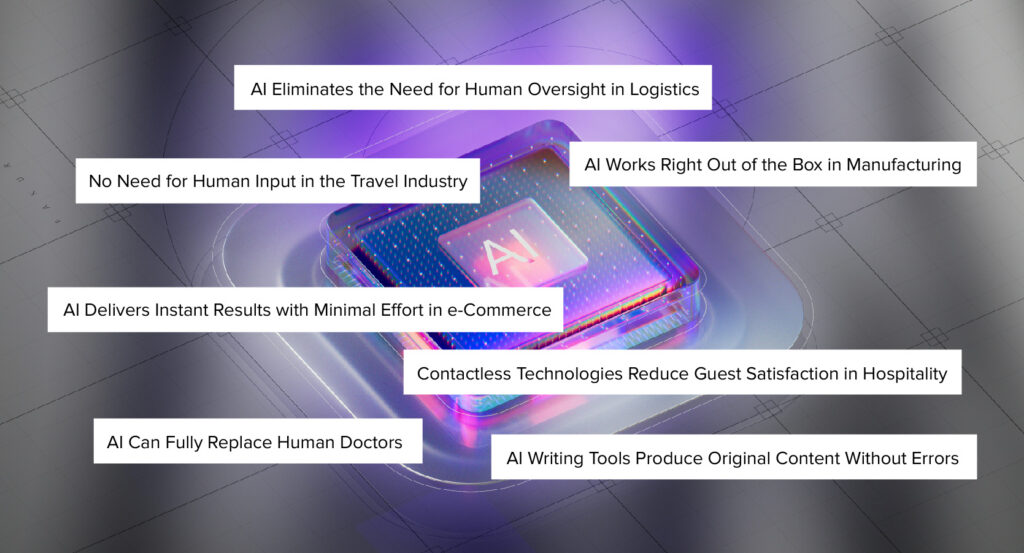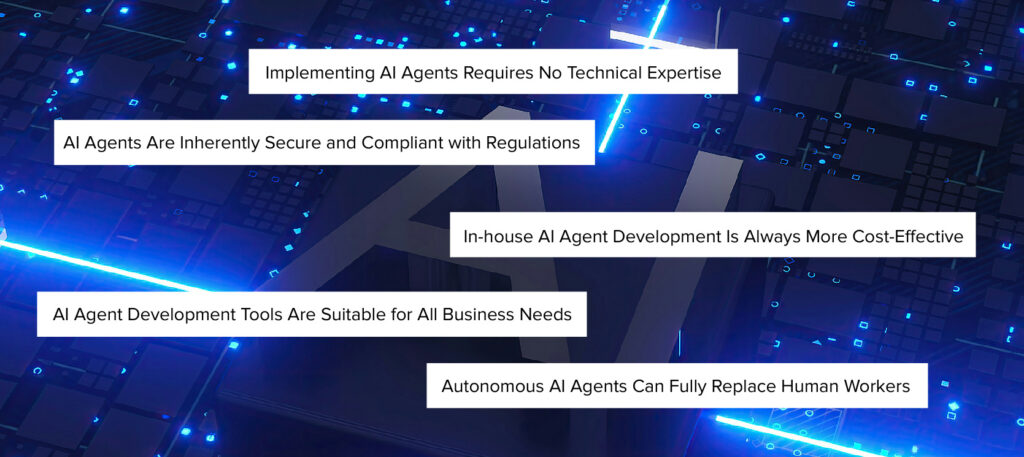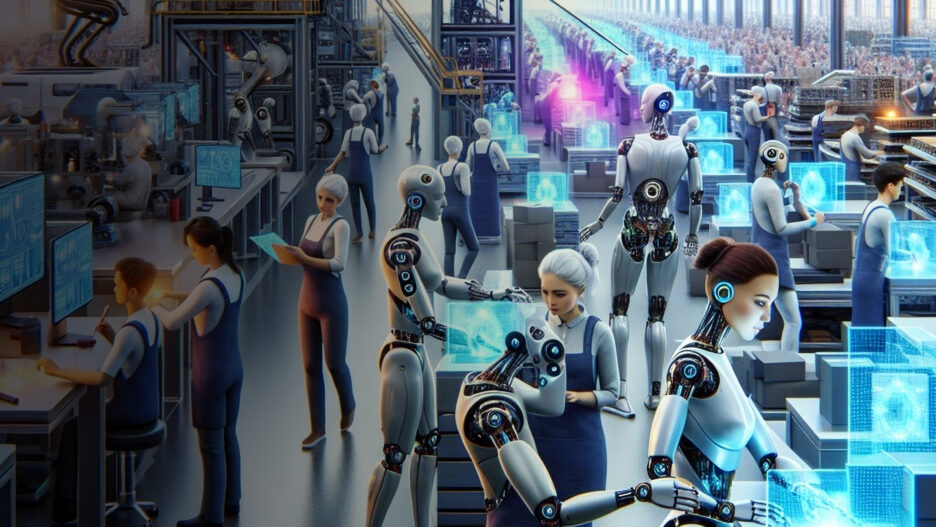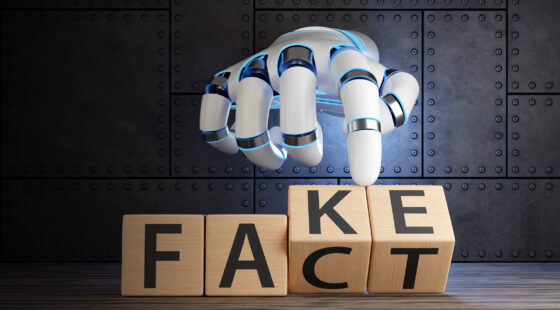AI is expanding and becoming part of all areas of our lives, but so are misconceptions about it. In healthcare, logistics, and e-commerce, AI helps speed up processes, from handling simple, routine tasks to fully replacing specific roles with dedicated AI agents. Does this mean humans should worry about losing their jobs to artificial intelligence? Not necessarily. They say, “AI won’t take your job, but someone using it might.” Learn why professional human oversight matters and how it dispels common myths about AI in our blog.
Myths About AI Across Industries

Every major shift in technology brings a mix of excitement and misunderstanding, and AI is no different. From manufacturing to healthcare, artificial intelligence is transforming how industries function. But alongside innovation, there are many misconceptions. AI is often seen as an all-knowing, fully autonomous solution, but the reality is more complex. Here’s a closer look at the most common AI myths in various industries and the facts that clarify them.
Myths About AI in Logistics: AI Eliminates the Need for Human Oversight
Those who are not very familiar with the logistics sphere might think it's something easily handled by an automation tool, not to mention AI. However, in practice, things are much more complicated.
| Myth Supporting Arguments | Reality |
| - Once trained with quality data, AI can handle all logistics scenarios flawlessly. | - Edge cases require human judgment because AI struggles with unexpected events like natural disasters or sudden port closures. - Bias is possible because AI decisions can reflect biased training data, so oversight ensures fairness. - Compliance and accountability require humans because regulations demand explainable decisions and human responsibility. - AI augments, not replaces, humans and frees people for strategic and customer-facing tasks. |
Myths About AI in the Travel Industry: AI Eliminates the Need for Human Input or Expertise
If the travel organization process can be reduced to compiling a list of possible trips based on specified criteria, AI could have handled it from start to finish. Luckily, in certain processes, human oversight remains essential, which means AI can’t fully replace travel agent experts, at least for now.
| Myth Supporting Arguments | Reality |
| - AI can instantly search all data and plan better trips than humans. - Automated recommendations are objective and error-free. | - Hallucinations & errors happen when AI sometimes invents attractions, lists closed businesses, or gives wrong info. - AI lacks human context and often misses cultural nuances, traveler preferences, accessibility needs, and emotional factors. - Regulatory errors are common for AI and include outdated visa requirements or incorrect entry details. - Logistical planning is flawed since AI tends to overpack itineraries, misjudge distances, and ignore transfer times. |
Myths About AI in Healthcare: AI Can Fully Replace Human Doctors
Even in a vital industry like medicine, artificial intelligence is seen as a threat to doctors’ jobs because it can reportedly make diagnoses based on extensive research. The question still is whether these diagnoses are accurate and what the cost of their mistakes might be.
| Myth Supporting Arguments | Reality |
| - AI is more accurate than humans at diagnosing disease because it eliminates the ‘human error’ factor. - Because AI learns from enormous datasets, it knows more than any single doctor. | - Physician distrust & legal/ethical risk are the reasons many doctors express concern about AI making clinical decisions. - AI lacks empathy and the nuance of human judgment (patient history, emotional state, non-verbal cues) that often influences diagnosis and treatment. - Data bias and errors occur because AI models depend on high-quality, representative data. If that data is biased, incomplete, or outdated, the results are less reliable. - Guidelines (e.g. FUTURE-AI) emphasize fairness, explainability, trustworthiness, and human in-loop supervision; AI tools are seen as aids, not replacements. |
Myths About AI in e-Commerce: AI Delivers Instant Results with Minimal Effort
AI in e-commerce is often marketed as a magic button: flip the switch and watch your sales skyrocket. But the truth is, achieving real results requires time, quality data, and ongoing tweaks. Here’s why the idea of “instant results with zero effort” doesn’t quite match reality.
| Myth Supporting Arguments | Reality |
| - Once you plug in an “AI tool,” sales and conversion rates will shoot up overnight. - Minimal setup and maintenance needed, because AI runs itself. | - Setup and tuning take time — AI-based recommendation systems, dynamic pricing tools, chatbots, etc., require careful configuration, training, integration, and monitoring. - Data quality & volume are crucial, because insufficient or biased product/customer data leads to bad recommendations, wrong optimizations, or poor user experience. - AI tools need continuous updating (algorithms, content, models), and humans must interpret/adjust outputs, especially when markets change. - Extra costs — while some aspects are “set-and-forget,” many involve ongoing expenses: data cleaning, model retraining, system maintenance, fixing errors, and addressing customer issues. |
| Interesting fact Despite the obvious imperfections, one shouldn’t underestimate the impact of AI. For example, streaming platforms like Netflix and Spotify rely on AI for personalized content recommendations, driving up to 80% of user engagement. |
Myths About AI in Manufacturing: AI Works Right Out of the Box
The promise of instant results from AI in manufacturing is enticing, but the reality is more complex. Genuine improvements arise from careful planning, skilled personnel, and continuous monitoring.
| Myth Supporting Arguments | Reality |
| - AI in manufacturing is plug-and-play and works immediately with little setup. | - AI systems in manufacturing demand significant setup time, including data preparation, model training, and integration with existing systems. - Need for skilled personnel — implementing AI in manufacturing requires personnel with specialized skills in AI, data science, and systems integration. - High initial costs due to the substantial investments in hardware, software, and infrastructure. - Ongoing maintenance and monitoring — same as in other industries, AI systems in manufacturing require continuous monitoring, updates, and adjustments to maintain optimal performance and adapt to changing conditions. |
Myths About AI in Hospitality: Contactless Technologies Reduce Guest Satisfaction by Depersonalizing Experiences
Switching from criticizing to approving. Sometimes, AI is unfairly underestimated and viewed as a weak spot in customer service. Let’s put this myth to rest once and for all.
| Myth Supporting Arguments | Reality |
| - AI-powered contactless services replace human touch, making interactions impersonal. - Guests prefer traditional staff and face-to-face interactions over AI-driven systems. | - Enhanced guest satisfaction — studies indicate that AI-powered contactless technologies can improve guest satisfaction by streamlining processes and reducing wait times. - Automation of routine tasks allows staff to focus on personalized service, enhancing overall guest experience. - AI-driven personalization tailors guest experiences, offering customized recommendations and services. - AI-powered chatbots and virtual concierges provide instant, 24/7 responses while complementing (not replacing) human staff. |
Myths About AI in Copywriting: AI Writing Tools Produce Original Content Without Errors
AI talks like a human, so it seems logical to assume it can produce the same quality content as a human. However, there are some hurdles, such as a lack of empathy or non-linear logic, and limited creativity.
| Myth Supporting Arguments | Reality |
| - AI writing tools always generate totally original content. - The content is error-free and factually accurate. Human editing is optional. | - Hallucinations happen: AI can invent facts (e.g., Google’s AI summary once claimed cats had been to the moon). - Plagiarism risks, because AI outputs may closely mirror existing content, creating originality concerns. - The tone is often generic and the content lacks depth, nuance, or brand voice (unless it’s trained specifically). - Not reliable for complex topics: AI struggles with technical accuracy without human oversight. |
Currently, the most effective and reliable way to use AI is in conjunction with professional human oversight. When employed this way, AI can truly work wonders and significantly enhance your business workflows. To ensure seamless collaboration between AI and humans, it’s best to consult the AI professionals at the Svitla team.
Common Myths About AI Agents

AI agent is another popular AI-related term that many people mistakenly see as a complete replacement for human workers. The truth is, when properly trained in a specific area, AI agents can perform certain tasks and make decisions, but the question remains:
Who is responsible if such an agent makes a mistake that could lead to serious consequences?
Let’s discuss the common misconceptions about AI agents and how to prevent such unfortunate situations in the second part of our blog.
Myth About AI Agents #1: Implementing AI Agents Requires No Technical Expertise
People often believe that AI agents' development software and training data are enough to create digital assistants that perform all their tasks perfectly and fully autonomously. Take a look at what it really means in practice.
| Myth Supporting Arguments | Reality |
| - AI agents are plug-and-play — you just configure them and they work. - Little or no coding, ML, or infrastructure work needed. | - Technical integration is complex — AI agents need to tie into existing systems: APIs, databases, CRMs, etc. Misalignment leads to failures. - Data quality and preparation costs, because agents require clean, labeled, structured data; bad data harms performance. - Scalability & performance challenges — What works in a test environment often breaks under real load or in multi-user settings. - Agents act autonomously; therefore, oversight, secure access, audit trails, and ethical safeguards are a must. - Building and maintaining agents involves specialized skills, such as prompt engineering, memory/context frameworks, monitoring, fallback handling, and domain expertise. |
Myth About AI Agents #2: AI Agents Are Inherently Secure and Compliant with Regulations
Remember that AI agents, like any AI tools, might handle your business's sensitive or internal information. That’s why strong security measures are essential. Sadly, many people only realize this after a leak or breach occurs. However, it’s always better to prevent problems upfront than to deal with the fallout afterward.
| Myth Supporting Arguments | Reality |
| - No need for security experts, because AI agents come pre-secured by the vendor with built-in compliance. | - Prompt injection risks: AI agents can be tricked into leaking sensitive data or bypassing instructions if security guardrails aren’t properly configured. - DIY setups often grant agents excessive API or database permissions, increasing breach risk. - Compliance gaps: Regulations like GDPR, HIPAA, and SOC2 require intentional configuration and audit logging, not automatic out-of-the-box compliance. - Continuous monitoring is necessary because security threats evolve. Agents need ongoing monitoring, red-teaming, and patching, not a one-time setup. |
The 30% Rule In most complex roles, approximately one-third of tasks can currently be automated using AI. The rest of the work still depends on human expertise, understanding of context, and supervision.
Myth About AI Agents #3: AI Agent Development Tools Are Universally Suitable for All Business Needs
There’s no such thing as a versatile AI agent — each one is unique in its way. Maybe, for very simple and basic tasks, “one-size-fits-all” agents could work, but for more complex or specific situations, it will likely cause problems.
| Myth Supporting Arguments | Reality |
| - The same AI agent tool works well for any business size, domain, or workflow. - “One-size-fits-all” tools will scale easily across tasks and data types. | - Limited real-world applicability — Many agents perform acceptably in narrow tasks (e.g. customer support), but fail in complex business workflows. - Agents might have weak memory, often reset in each session, have limited recall over long tasks, or lose earlier context in multi-step workflows. Not suited for tasks needing persistent state or long-term planning. - When agents invoke external tools or APIs, even small mismatches in parameters or schemas cause errors. Different domains require different toolsets. - Agents must be tailored for compliance, security, or domain-specific knowledge. Generic tools often lack guardrails, which leaves gaps in trust, legality, or performance. |
Myth About AI Agents #4: In-house AI Agent Development Is Always More Cost-Effective than Outsourcing
It may seem that utilizing your existing resources is more cost-effective than hiring an external team for a specific project. However, this is often not true in the long run, and here’s why.
| Myth Supporting Arguments | Reality |
| - Doing everything in-house saves money. You avoid vendor fees and get control, so it must be cheaper. | - Hidden infrastructure & operational costs: in-house teams require hardware, cloud compute, storage, software licenses, etc., which add up quickly. - Skilled AI/ML engineers are in high demand; hiring and retaining them is expensive and competitive. - Longer time to market: Building your own AI agent from scratch takes more time compared to outsourcing. - Ongoing maintenance that includes updating models, fixing bugs, retraining with new data, maintaining security and compliance are continuous costs. Many in-house projects underestimate this burden. - For pilot projects or less core functions, outsourcing delivers faster results at lower risk and cost while still allowing you to scale or move in-house later if needed. |
Myth About AI Agents #5: Autonomous AI Agents Can Fully Replace Human Workers
Many people today fear that AI agents will completely replace their jobs, regardless of the industry they work in. While there is some basis for this fear, the idea is not entirely accurate.
| Myth Supporting Arguments | Reality |
| - Once built, AI agents can run autonomously and replace entire teams. - No human oversight is required — agents will just take over operations. | - Many job activities are not automatable today. A McKinsey analysis shows that only ~45 % of tasks across occupations are technically automatable. - In practice, hybrid use dominates: businesses deploy agents to assist humans (e.g. transcribe meetings, summarize tasks), not fully replace them. - Human judgment and emotional intelligence are still essential, and complex decisions involving ethics, context, ambiguity, or relationships are beyond agent’s capabilities. - Reliability, error, and oversight are required because agents can make mistakes; humans must monitor, correct, and intervene. |
Summing Up
As AI keeps transforming business operations, it’s crucial to see past the hype and recognize what’s real. AI agents and automation tools provide value, but only with a smart strategy, human insight, and good governance. Rushing can lead to messy integrations, compliance issues, or unmet expectations. An experienced technology partner can help avoid these pitfalls and ensure your AI projects succeed.
With Svitla’s deep expertise in AI integration and custom software development, companies can turn complex AI potential into measurable, sustainable impact.





![[Blog cover] Agentic AI vs traditonal automation](https://svitla.com/wp-content/uploads/2025/09/Blog-cover-Agentic-AI-vs-traditonal-automation-560x310.jpg)